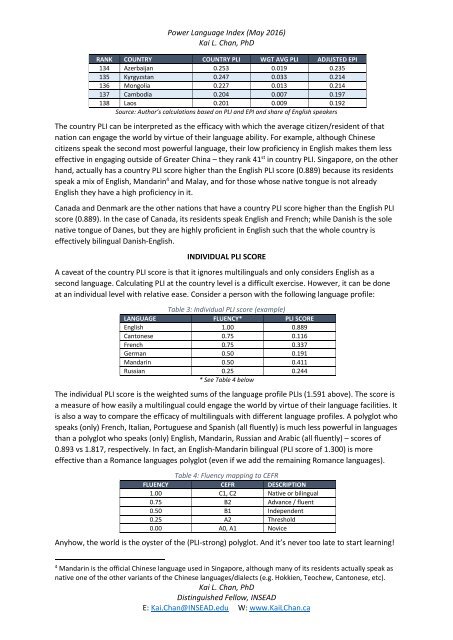POWER LANGUAGE INDEX
Kai-Chan_Power-Language-Index-full-report_2016_v2
Kai-Chan_Power-Language-Index-full-report_2016_v2
Create successful ePaper yourself
Turn your PDF publications into a flip-book with our unique Google optimized e-Paper software.
Power Language Index (May 2016)<br />
Kai L. Chan, PhD<br />
RANK COUNTRY COUNTRY PLI WGT AVG PLI ADJUSTED EPI<br />
134 Azerbaijan 0.253 0.019 0.235<br />
135 Kyrgyzstan 0.247 0.033 0.214<br />
136 Mongolia 0.227 0.013 0.214<br />
137 Cambodia 0.204 0.007 0.197<br />
138 Laos 0.201 0.009 0.192<br />
Source: Author’s calculations based on PLI and EPI and share of English speakers<br />
The country PLI can be interpreted as the efficacy with which the average citizen/resident of that<br />
nation can engage the world by virtue of their language ability. For example, although Chinese<br />
citizens speak the second most powerful language, their low proficiency in English makes them less<br />
effective in engaging outside of Greater China – they rank 41 st in country PLI. Singapore, on the other<br />
hand, actually has a country PLI score higher than the English PLI score (0.889) because its residents<br />
speak a mix of English, Mandarin 4 and Malay, and for those whose native tongue is not already<br />
English they have a high proficiency in it.<br />
Canada and Denmark are the other nations that have a country PLI score higher than the English PLI<br />
score (0.889). In the case of Canada, its residents speak English and French; while Danish is the sole<br />
native tongue of Danes, but they are highly proficient in English such that the whole country is<br />
effectively bilingual Danish-English.<br />
INDIVIDUAL PLI SCORE<br />
A caveat of the country PLI score is that it ignores multilinguals and only considers English as a<br />
second language. Calculating PLI at the country level is a difficult exercise. However, it can be done<br />
at an individual level with relative ease. Consider a person with the following language profile:<br />
Table 3: Individual PLI score (example)<br />
<strong>LANGUAGE</strong> FLUENCY* PLI SCORE<br />
English 1.00 0.889<br />
Cantonese 0.75 0.116<br />
French 0.75 0.337<br />
German 0.50 0.191<br />
Mandarin 0.50 0.411<br />
Russian 0.25 0.244<br />
* See Table 4 below<br />
The individual PLI score is the weighted sums of the language profile PLIs (1.591 above). The score is<br />
a measure of how easily a multilingual could engage the world by virtue of their language facilities. It<br />
is also a way to compare the efficacy of multilinguals with different language profiles. A polyglot who<br />
speaks (only) French, Italian, Portuguese and Spanish (all fluently) is much less powerful in languages<br />
than a polyglot who speaks (only) English, Mandarin, Russian and Arabic (all fluently) – scores of<br />
0.893 vs 1.817, respectively. In fact, an English-Mandarin bilingual (PLI score of 1.300) is more<br />
effective than a Romance languages polyglot (even if we add the remaining Romance languages).<br />
Table 4: Fluency mapping to CEFR<br />
FLUENCY CEFR DESCRIPTION<br />
1.00 C1, C2 Native or bilingual<br />
0.75 B2 Advance / fluent<br />
0.50 B1 Independent<br />
0.25 A2 Threshold<br />
0.00 A0, A1 Novice<br />
Anyhow, the world is the oyster of the (PLI-strong) polyglot. And it’s never too late to start learning!<br />
4<br />
Mandarin is the official Chinese language used in Singapore, although many of its residents actually speak as<br />
native one of the other variants of the Chinese languages/dialects (e.g. Hokkien, Teochew, Cantonese, etc).<br />
Kai L. Chan, PhD<br />
Distinguished Fellow, INSEAD<br />
E: Kai.Chan@INSEAD.edu W: www.KaiLChan.ca


